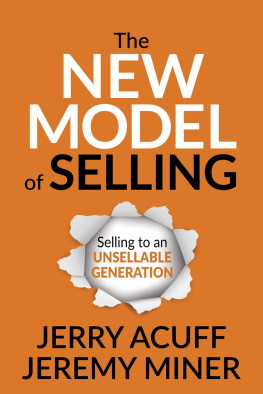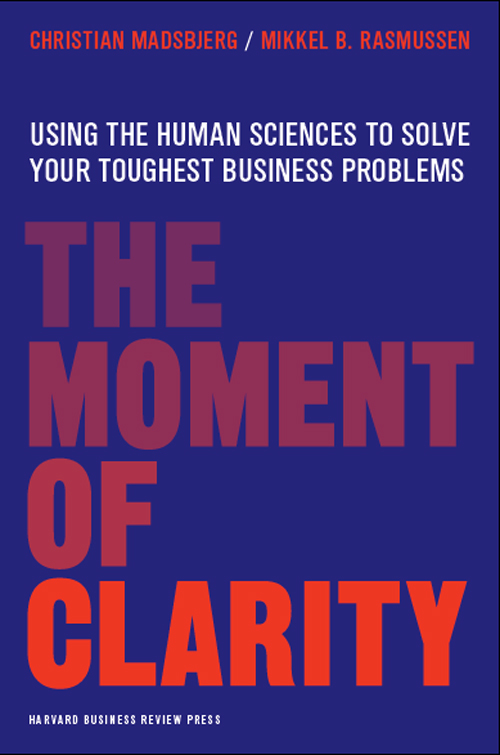Copyright 2014 Christian Madsbjerg and Mikkel B. Rasmussen
No part of this publication may be reproduced, stored in or introduced into a retrieval system, or transmitted, in any form, or by any means (electronic, mechanical, photocopying, recording, or otherwise), without the prior permission of the publisher. Requests for permission should be directed to , or mailed to Permissions, Harvard Business School Publishing, 60 Harvard Way, Boston, Massachusetts 02163.
I S YOGA A SPORT? This question was posed by a senior vice president in one of the worlds largest makers of athletic shoes during an off-site meeting in the spring of 2003. He was leading the meeting with the aim of creating a strategy for the sports performance division of the company for the next five to eight years.
The other executives were having a heated discussion about product planning, technology briefs, design strategy, sales targets, and must-win battles, but in the middle of the session, the senior VP felt compelled to bring up the question that had been plaguing him: Is yoga a sport? To the other executives around the table, this line of inquiry seemed to come from out of the blue. The room turned silent for several interminable seconds before the jokes began.
Yogaa sport? Thats a good one, clucked the director of global marketing. Okay, guys, lets finish the discussion on design strategy, and then maybe we can return to the yoga thing tomorrow before breakfast. Anyone up for some sun salutations? Everyone laughed, and the meeting resumed. They planned strategies, pinged numbers around, and settled on the big story for 2010.
The question was deemed off topic on that particular day. Yoga was fun and healthy, but it wasnt serious.
The question, however, was.
The senior VP was feeling lost. It wasnt just yoga that was puzzling him. It was the entire culture of sport and exercisea culture that seemed to be shifting around him. Why were so many people attending fitness centers instead of playing competitive sports? Why were the yoga classes at the local gym packed with men in their thirties while membership in local sports teams was lagging? Why did it feel as though the most popular sports activity in the United States was exercising on an elliptical trainer? And at the other extreme: what was driving millions of people to spend hours and hours a week training for extreme sports events like ultra-marathons, twenty-four-hour mountain bike races, Ironman triathlons, and adventure challenges like marathons in the Sahara? None of these were traditional sports activities, and none of them belonged anywhere in the industrys strategies.
If you dont happen to work in the sporting goods industry, the senior executives confusion might strike you as odd. After all, it feels great to go to a yoga class or for a casual run in the park. For the majority of people in wealthier countries, participation in sports is about staying fit, feeling good, losing weight, and maintaining a balance in life.
Executives in the sports shoe business, however, see things quite differently. Just by asking the question Is yoga a sport? the senior VP was dismantling the core assumption driving the entire industry: sports products are created to help athletes win .
When organized sports took on mass appeal in the 1950s, sporting goods companies suddenly had a large consumer base of competitive athletes. The notion of competition and providing an edge drove much of the industry innovation for the next fifty years. It was assumed that customers would choose the products best able to give them a competitive advantage. This is why so many sports companies use the language of a highly sophisticated car engine when they launch a new pair of running shoes: the GEL-Kayano series takes a stop at never approach, with top-of-the-line features like Heel Clutching System and Dynamic DuoMax. Four seasons a year, every sporting goods company in the market launches a new running shoe with a new futuristic design element: whether its Dynamotion Fit, Lunarlon and Flywire technologies, or Wave Creation 14, every word is painstakingly chosen to communicate cutting-edge technology. If you did the mathnumber of running shoe brands, multiplied by the number of performance technology introductions, times the number of seasonsyou would encounter hundreds of innovations in the sports shoe category every single year.
Winning is the cultural DNA of the entire sports industryits raison dtreand for good reason. Over the last fifty years, the selling of competitive advantage has brought astounding growth in market share and profits. Companies like Nike, Adidas, Puma, and New Balance have all more than quadrupled their size since the 1980s. Until the late 1990s, the boundaries and value proposition of the business were relatively clear: although executives would tweak and improve upon their products and processes, the same fundamental equationbetter performance equals winninginformed every decision. If something went wrong, it was simply a matter of tracing the steps back from that logic to discover why.
And then, all of a sudden, everything changed. It wasnt that the technical performance of the equipment had changed. It was the consumers who had changed. People were behaving differently, and no one knew why. In 2003, the senior VP sensed the change although he couldnt yet articulate its underlying causes. If yoga is a sport, then businesses have to allow for the possibility that most people dont do sports to win. By 2012only nine years laterthe market for yoga and gym clothing and other similar fitness apparel constituted more than half of the entire sporting goods market. The market for walking shoes, gym shoes, and jogging shoes had grown at double-digit rates, while the market for basketball shoes, tennis shoes, and baseball shoes was decreasing. The number of people attending fitness classes outnumbered the number of people active in organized sports by a factor of five, and more than 50 percent of demand for sports products was coming from women. According to a recent study, the top three key motivational factors for people doing exercise were positive health, weight management, and appearance. Contrast that with the key motivational factors for competitive athletes in the same survey: competition, challenge, and enjoyment. Most unexpected of all, some of the biggest innovations in exercise were not even coming from inside the sporting goods industry but were coming from outsiders like EA Sports, Microsoft Kinnect, Nintendo Wii, and Garmin.
Making the Invisible Visible
In hindsight, it is easy to see how things were changing. But step back to 2003, and place yourself inside the corporate insularity along with the other executives at the sports shoe company. Imagine the view from your office window every day: your fellow colleagues playing soccer or running along a track or biking to work. Imagine conversations over lunch while you choose from a wide assortment of performance-enhancing nutritional offerings at the company cafeteria: who logged in how many miles? What was so-and-sos time on the last 10K?
The competitiveness that had always driven innovation and strategy in the industry was explicitly and tacitly affirmed in every interaction occurring within the company itself. From the very moment you entered the campus of the organization, professional athletes were on displaysome trying out new equipment and others there to train for various events. During most breaks and lunches, executives didnt stay indoors at their desks eating. It was a given that the majority of the company employees would be outside pushing themselves toward greater athletic achievement. In fact, most of them had sought out a position at the company for that very reason: they thrived on competition. It was the main reason they themselves participated in sports.









